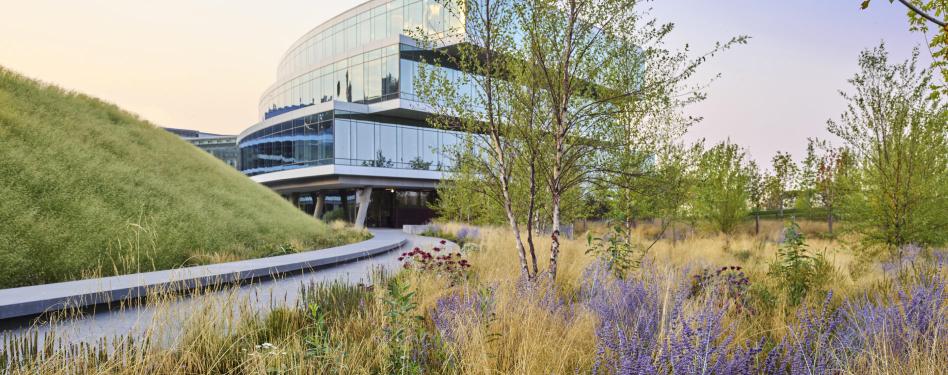
Feature image: The SITES Gold Expedia Group Seattle Campus. Photo courtesy of Marion Brenner.
SITES is a rating system that guides, evaluates and certifies sustainability and resilience in the design, development and management of landscapes and other outdoor spaces. SITES supports landscape architects, planners, developers and others in implementing nature-based solutions. This means that SITES projects prioritize biodiversity and mitigate climate change while conserving resources, improving public health and providing economic benefits.
Delve into the benefits and science behind these important ecosystem services in a new resource, “Why SITES?”
Who can use SITES?
SITES certification applies globally to a wide variety of project types and sizes and for sites with or without buildings—ranging from parks to corporate campuses, urban development projects to universities, and more. By protecting and restoring ecosystem services, SITES provides essential benefits to the environment, property owners, and local and regional communities and economies.
What are the benefits of SITES certification?
Enhancing the sustainability of a landscape development project has myriad benefits. By protecting, restoring and generating ecosystem services, SITES-certified projects promote climate regulation, protect air and water quality, control flooding, improve resilience, mitigate risks from potential hazards, enhance biodiversity, conserve resources, and reduce waste.
Carbon, energy and climate
SITES guides projects in reducing carbon emissions and regulating climate, creating positive impacts at multiple scales. Strategies such as protecting and restoring native habitats, restoring soil, and increasing key vegetation cover help to cool cities and communities.
Promoting the use of low-impact materials, electric or manual maintenance strategies, and energy-efficient equipment helps to reduce carbon emissions and energy consumption. There are many ways to reduce carbon in our built environment; however, only landscapes have the unique capacity to sequester and store carbon while creating a more livable place.
Biodiversity
Biodiversity is lost due to habitat exploitation, climate change, pollution and invasive species. Biodiversity is necessary for the conservation of biological and genetic diversity, as well as the evolutionary processes that support the long-term health and survival of the Earth’s many inhabitants. SITES enriches biodiversity through strategies that protect and restore ecosystems. Additionally, SITES prohibits the use of invasive plants and requires projects to have an invasive species management plan and to use an integrated pest management approach.
Water conservation and quality
Natural systems are of critical value for their ability to store, clean and distribute water and to serve as a habitat for a variety of species. SITES encourages designs that conserve water, maximize the use of precipitation, protect water quality and protect and restore aquatic resources. The goal is to incorporate strategies and technologies that restore or mimic natural systems and ultimately value water as a critical resource rather than a waste product.
Resilience
SITES-certified projects mitigate floods, droughts, heat waves, wildfires and other hazards that pose risks to property owners and the health and safety of humans and habitats. These risks are exacerbated by climate change and high-impact development. SITES mitigates these hazards by protecting and restoring landscapes, enhancing biodiversity, and promoting the implementation of green infrastructure and ongoing sustainable management strategies.
Materials and waste
SITES reduces the amount of waste sent to landfills and incinerators through strategies such as efficient use, reuse, recycling and composting of materials. These methods are encouraged during construction, renovation and demolition of a project site as well as throughout the entirety of a site’s life cycle. Project teams further reduce the production of waste from SITES-certified landscapes by purchasing sustainable materials from responsible manufacturers.
Human health and well-being
SITES landscapes promote human health and well-being by regulating the climate, mitigating natural disasters and preventing disease and illness. SITES further supports both physical and mental health by promoting outdoor opportunities for physical activity, restorative and aesthetic experiences, mental restoration, and social interaction.
Community benefits
SITES encourages projects to address social equity and to improve economic opportunities in their design and development choices. In doing so, SITES landscapes can contribute to building a more stable and engaged community that reflects the regional and cultural identity.
SITES certification offers high-impact, long-term benefits to landscape development projects that align with the global push for biodiversity health. To learn more about the benefits of SITES certification, access the “Why SITES?” resource.
